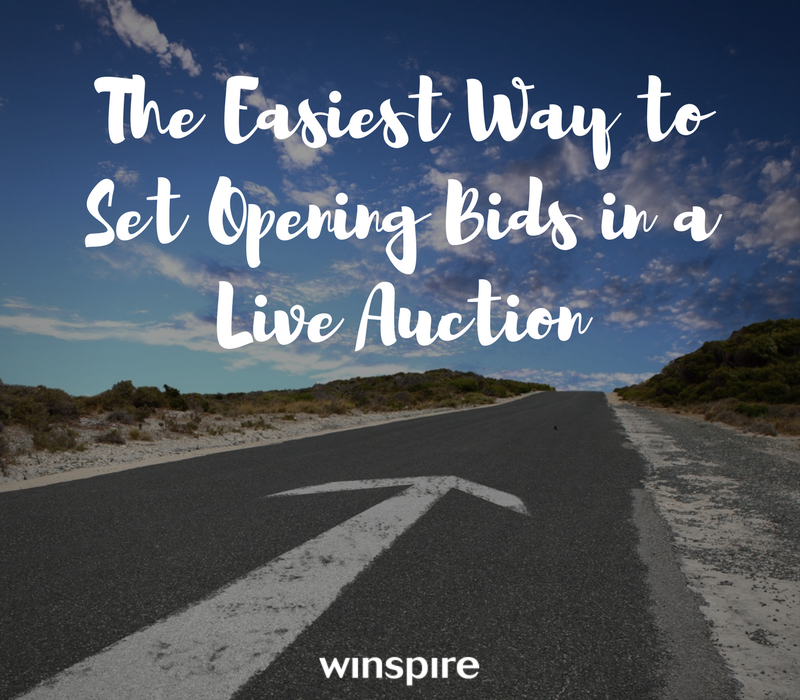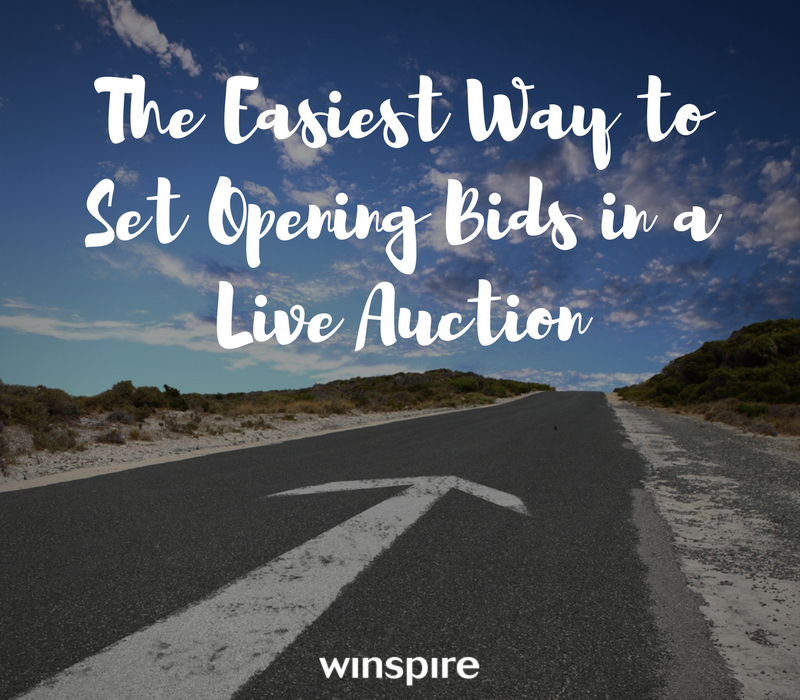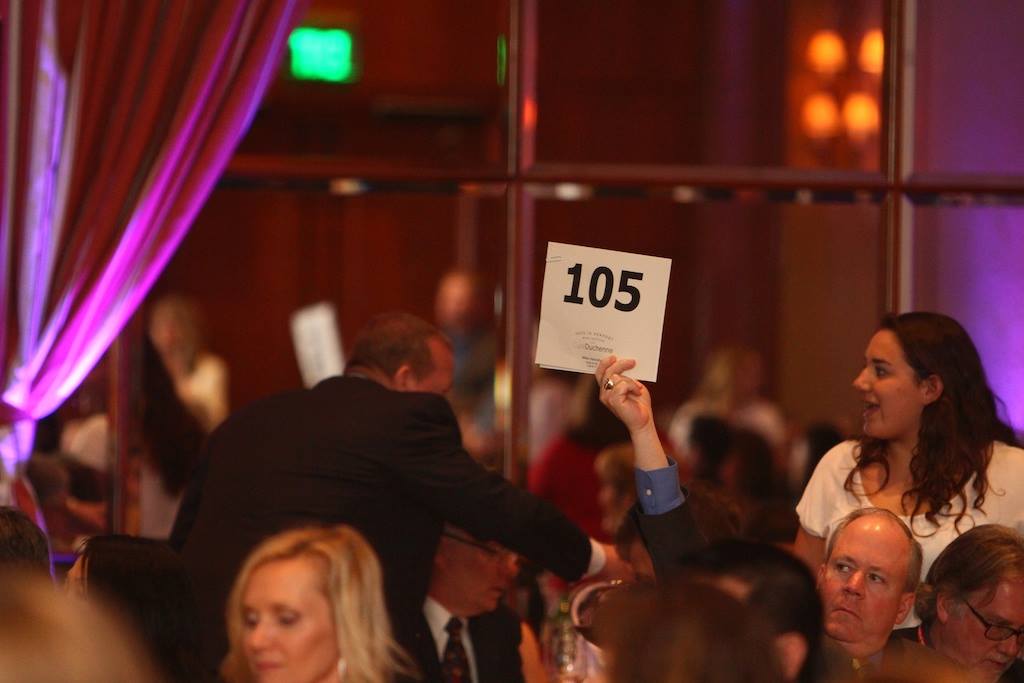The easiest way to set opening bids in your live auction, is to leave it to the pros! Check out these real-life submissions from recent webinar Q&As…
“Do fundraising auctioneers typically know how to start the bidding in a live auction, and do you have any recommendations as to what amounts to start at?”
“What happens if you use consignment items, and no one bids enough money to cover the cost for the organization? Do you even start the bidding below the consignment price, or do you start at 20 percent above?”
Knowing best practices on starting bids and using consignment items could be the difference between missing and exceeding your revenue goals. Read on for insider tips on how professionals facilitate a live auction.
1. Do fundraising auctioneers typically know how to start the bidding in a live auction?
“Yes – if they’re worth a darn, your fundraising auctioneer will know where to start the item,” says Scott Robertson, benefit auctioneer, in a recent Winspire webinar. “They may not be able to say before the auction where to start, but they’ll be able to tell during the auction.”
If you’ve never worked with an auctioneer before, rest assured you won’t be on the hook for determining starting bids. There’s no one-size-fits-all formula that can accommodate all live auction events and items.
Remember: Where bidding starts has no bearing whatsoever on where the bids finish.
2. Do you have any recommendations as to what amounts to start at?
The optimal starting bid depends on your audience, the exclusivity and perceived value of the item, and the momentum in the room, plus the particular style of your benefit auctioneer.
With so many different factors at play, try to focus on appropriate bid increments, like incremental bid raises you’d find on a silent auction bid sheet, rather than setting certain starting bids.
“Say you have an item worth $7,000. I’ve had auction committees suggest starting at $5,000, but I can’t get any momentum with that figure. If I start at $5,000, well, one person bids $5,000, someone else bids $6,000, someone else bids $7,000. Just like that, I’m done.
“I’d be much better served starting low enough where it’s a no-brainer price. In this case I’d start the item off at $2,000, then ramping it up rapidly: $2,000, $4,000, $6,000, $7,000, and now $8,000 – sold at $7,000. Even though I ended up at at the exact same price of $7,000, now we’re able to ramp up some momentum – and that sets the tone for your entire auction,” Robertson explains.
Starting low also enables you to engage more people than the handful of winning bidders – say, 15 or less – that end up actually taking home a live auction item.
What we’re not recommending: starting a $15,000 item at $1,000, for example.
At a fundraising event, time is money. Increasing bidding in tiny increments to cover a huge gap bloats the whole agenda – and loses the crowd’s interest. In this particular situation, Robertson says he might kick off bidding at $5,000, then go up in increments of $2,500 to get to $15,000.
Bottom line: Rather than relying on rules or formulas – trust your auctioneer’s breadth of experience and ability to read the room.
{{cta(‘2a6779a6-bbb4-43fe-a53c-ad87f4954809’)}}
3. What happens if bidding doesn’t reach the cost of consignment items?
Consignment or “no-risk” auction items are big-ticket, premium items (like Winspire travel packages) that aren’t fully donated, but come with a base price instead. Since Nonprofits keep the portion of the winning bid above the base price, we typically recommend setting a minimum bid of at least 20 percent higher than the cost to ensure a significant return.
What happens if bidding doesn’t reach the minimum profitable price you set? You don’t owe a dime. It’s as simple as that!
Here’s fellow benefit auctioneer specialist Danny Hooper’s take on selling consignment travel – and why it’s like picking a $500 bill up off the ground.
With Winspire, your organization only pays for trips that have successfully sold. It really is no risk.
4. Do you start bidding below the consignment price, or do you start at 20 percent above?
There are two valid schools of thought when it comes to selling consignment: You can either start bidding below the consigned price to ramp up momentum, or start at your minimum profitable price (i.e. 20% above the cost).
What would Robertson do? Check out the next 3 minutes or so of a recent Winspire webinar; the video is queued up to the time of this specific question (at 1h 39m).
“We’re not going to lose money with consignment items,” Robertson says. “I don’t say ‘sold’ if the item doesn’t sell – I just say thank you, and we move on to the next item.”
When it comes to selling no-risk packages, here’s 39-year auctioneer veteran Doug Sorrell‘s take…
“I tell the guests, ‘In a perfect world everything is totally donated. We aren’t there yet… and this next trip is an example. The committee wanted to offer this spectacular package, but it has a modest cost. So if the committee can make a small amount, I’m permitted to sell it. If we don’t reach that figure, we’ll have to pass. I’m sure you understand. After all, this is a Fund Raiser!’
I’ve not sold packages plenty. Never had a complaint. I’m honest with people and upfront, and they respect the honesty.”
Looking for a qualified benefit auctioneer in your state? We are here to help! Simply click below or leave a comment to share your organization name, state, event type and date. We’ll leverage our extensive charity auction networks and experience to recommend an auctioneer for you.
{{cta(‘78303450-25d5-4706-9e3c-4e1c54b413a7′,’justifycenter’)}}



